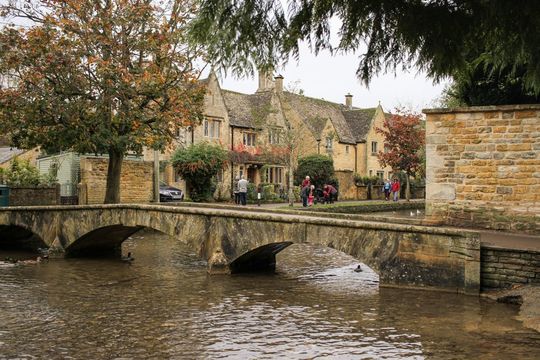
Bourton-on-the-Water, in the Cotswolds.
Susie Kearley discovers a host of attractions in the Cotswolds is a place of glorious countryside, heritage delights, beautiful waterways, and endless charm.
Bourton-on-the-Water, often dubbed the “little Venice of the Cotswolds” is famous for its motoring museum, its Grade II listed model village and for Birdland, an animal park, abundant with exotic birds from around the world.
Birdland
At Birdland beautiful parrots, including rare species, peer out of their aviaries as you walk by. There’s a daily flamingo talk and you can watch the colourful creatures squabble and flap as they feed. Global warming means that increasingly exotic species of birds are starting to migrate to the UK. Wild flamingos have reached France and it’s thought they will soon come to Britain. However, they’ll probably look a bit anaemic, because they won’t get the pink algae or shrimp that makes them pink! The keeper talks are really quite enlightening and add a lot to a visit.
Cotswold Motoring and Toy Museum

Cotswold Motoring and Toy Museum.
Up the road is the Cotswold Motoring and Toy Museum, where the galleries are filled, floor-to-ceiling, with old signs, bicycles, model planes, and of course, cars. There are dozens of wonderful classic vehicles, each with a tale to tell. One gallery is like walking into a scene from a Victorian village. There are Victorian shop fronts, a penny farthing, a horse-drawn carriage, and an Oxo van. Beside the door is an exhibit of old cameras and photographic processing equipment. See early rally cars and learn about the early days of car repair shops.
Another room contains a 1970s themed exhibit. Music from the era is played, and there are some wonderful retro items on display, including clothes, games, scooters, lights, interiors, and even some engine diagnostic machines. You might remember some of the games from your youth.
In an adjoining room, the exhibits change every year. When I visited, it had a 1964 theme with clothes from the era, scooters, and a Ford Zephyr, made in Dagenham. A mock 1964 lounge was littered with books and music that were popular or made the headlines that year. Guests exit through the toy museum, which houses toy cars and other vehicles and ornamental miniatures.
The Model Village
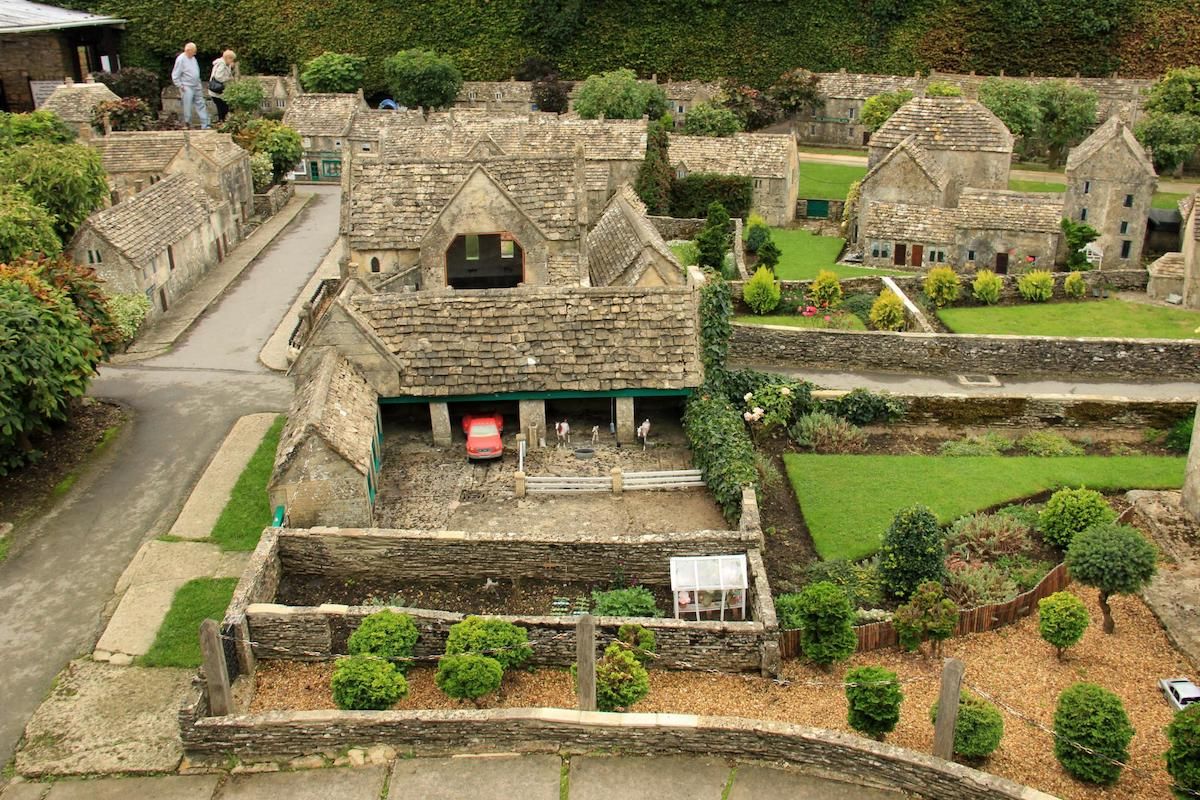
The Model Village.
Up the other end of town is The Model Village, a 1/9th scale replica of Bourton-on-the-Water. The buildings are made from Cotswold stone and as you walk through the miniature landscape, you’ll start to recognise parts of it. There’s the Post Office, Lloyds Bank, the sweet shop and the Windrush River running through the centre.
The sounds of hymns emanate from within the church buildings.
The model village dates to 1937 when it was first opened to celebrate the coronation of King George VI. It is thought to be the first stone model village ever created.
Lodge Park and Sherborne Park Estate
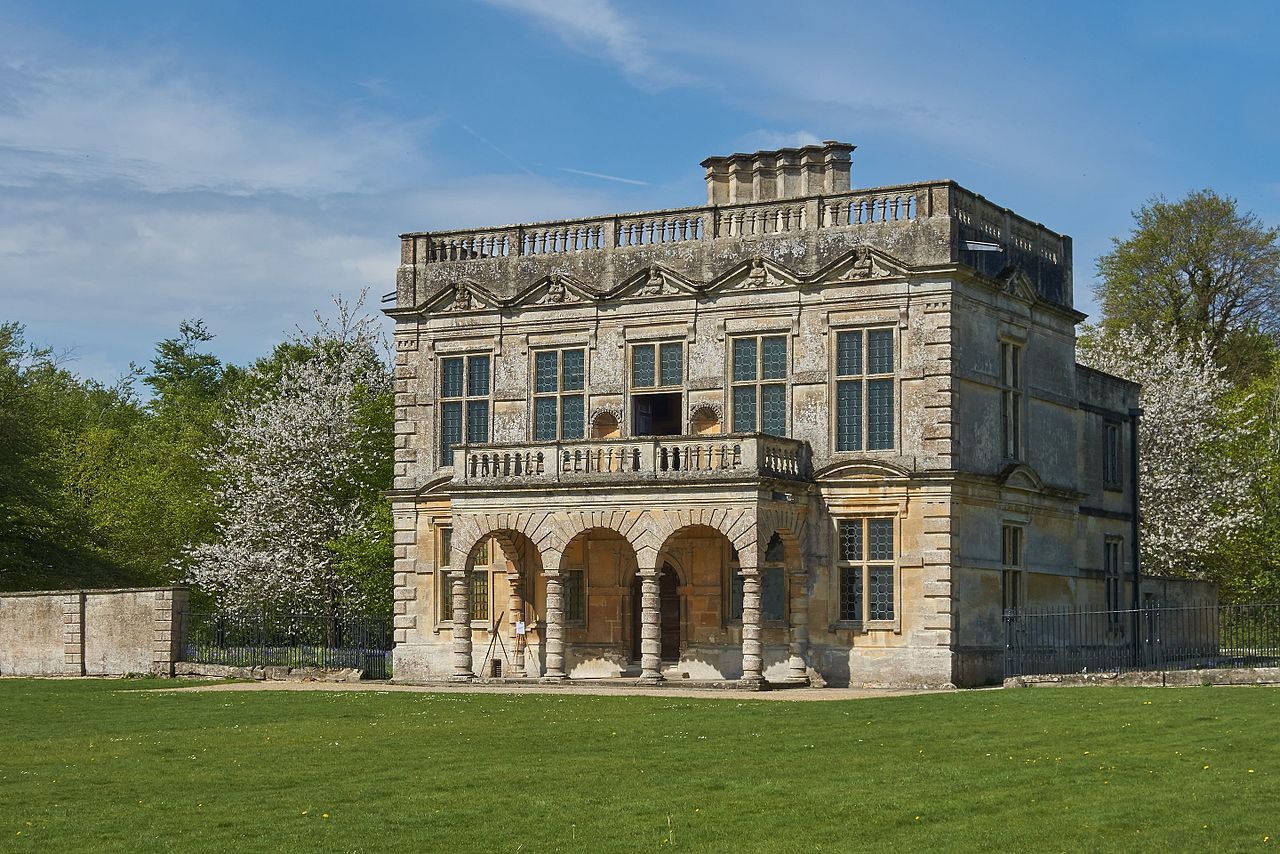
Lodge Park and Sherborne Park Estate
Lodge Park, eight miles away, offers acres of pretty parkland to explore. The Lodge was used as a grandstand in the 17th century by John Dutton, owner of the Sherbourne Estate, because he wanted to watch deer-coursing with his aristocratic friends. A deer was set loose on the course and chased by a single hound to give it a head start. Then a pack of dogs was released and a high-speed chase ensued. The animals reached about 40 miles an hour, which was considered really fast at the time. At the end of the course was a ditch to mark the finishing line and stop the dogs. There was another ditch to stop the deer, which was usually unharmed and returned to the herd.
Feasts and parties were held at the Lodge and deer were shot on the estate to be prepared for the banquet. However, the deer-coursing was essentially just a way of indulging Dutton’s love of gambling. If a large bet was placed, it was expected that blood would be shed. Fortunately for the deer this only happened occasionally.
The Lodge has an inviting entrance hall, lined with portraits and a painting of the estate. The Great Hall is an impressive room with a grand fireplace, walls lined with pictures, and a balcony overlooking the grounds. The aristocrats would have had a clear view of the race from this balcony. You can imagine the excitement and the party atmosphere as you explore the house and grounds.
Chedworth Roman Villa
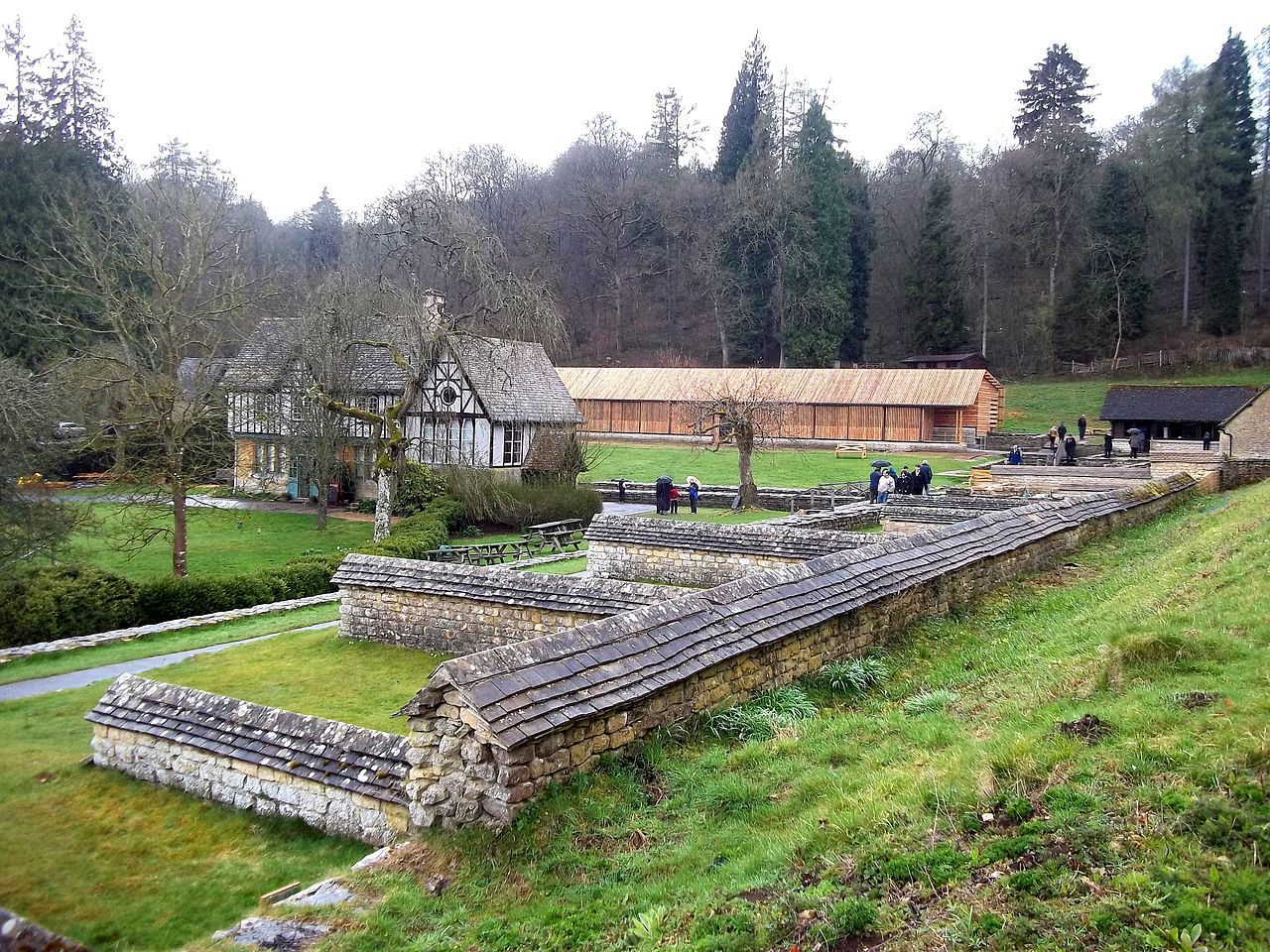
Chedworth Roman Villa
Nearby, Chedworth Roman Villa is home to some brilliant authentic Roman mosaics. Roman re-enactments and demonstrations help bring the period to life. You can join a guided tour to hear how the buried Roman villa was first discovered.
It was 1864 when a gamekeeper by the name of Thomas Margetts dug out his ferret from a rabbit hole in the woods. He dug up some mosaic tiles in the process and reported his find to John Scott, the owner of the land. A clearance of the woodland ensued and the full extent of this fabulous Roman villa was revealed.
Scott repaired some of the walls of the villa, putting tiles on top to protect them from the elements, but during his rushed clearance of the site, many of the smaller or less significant Roman artefacts were buried in what became the foundations of his new hunting lodge.
The villa ruins and lodge then became a party venue, with Scott showing off the archaeological finds to his friends. They all dined in the original dining room with its glorious mosaic floor, showing scant regard for its age or for careful preservation. Today, the mosaic floors are strictly off-limits, but you can view them from a raised walkway.
The guide takes you around the ruins, showing you the spot where the ferret was first dug out of the rabbit hole. There are no mosaics in that room today. There’s a pond, fed by a spring, which provided a constant flow of fresh water for the Romans. Indeed, it was probably the reason they built the villa in this location.
Roman snails are breeding on the site. They were introduced as a culinary delicacy by the Ancient Romans, and are now protected because they are endangered, even in their native Italy. The snails are huge, unusually pale in appearance, and can be spotted all around the villa ruins. There’s also a museum, a fabulous café and a shop selling books about the villa if you want to know more.
Chastleton House

Chastleton House
Another interesting heritage attraction in the area is Chastleton House, a Jacobean mansion, which was once owned by Barbara Clutton-Brock. She lived in the parlour with her 14 cats, while the rest of the house fell into a state of dereliction. She did open the house to the public during her lifetime but after her
husband died in 1976, she struggled with the maintenance and despite endeavouring to make some repairs, in 1991, ill-health forced her to leave.
The Grand Hall is the most impressive room, with detailed woodcarvings, armoury on the walls, and a long oak table. See the dining room, library, bedrooms and long gallery, which has the longest barrel-vaulted ceiling of its date in England. At the end of the long gallery is a museum room showing off clothes and artefacts from the era. Finally, you descend the stairs into the servants’ kitchen, where there’s a heavy iron stove and pewter plates on display.
Hailes Abbey
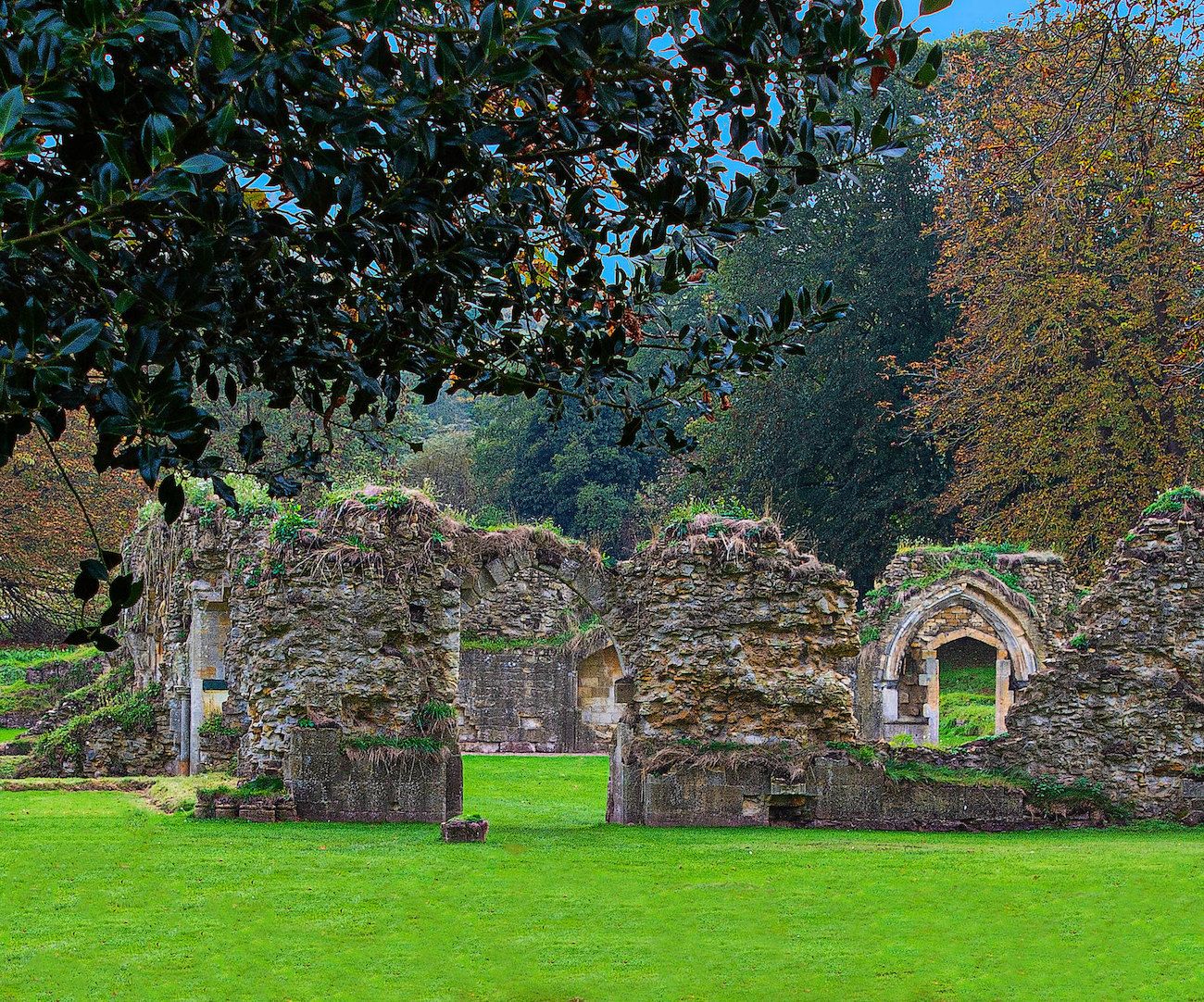
Hailes Abbey
If you like exploring monastic ruins and hearing about the monks, you’ll enjoy Hailes Abbey, near Winchcombe, where you can learn about the lives of the Cistercian monks who lived there in the 13th century. They spent 11 hours every day in prayer, three hours working, three hours reading, two hours eating, and they only got five hours sleep a night. Most of the time, they weren’t allowed to speak.
Lay brothers lived in the grounds too. They worked for the monastery for free and the Abbey gained great wealth by having unpaid workers generating income for them. Then in 1361, tragedy struck. The Black Death had not affected the monastery when it initially broke out in 1349, but its recurrence in 1361 devastated the Abbey’s population. Many of their numbers died. After that, there were few lay brothers to do the monastery’s work.
The Abbey Church was home to a precious vile of liquid that was claimed to be Christ’s blood. But in the 16th century, King Henry VIII, wanting to dissolve the monastery, declared that the holy vile had nothing in it but honey and red dye, so it was thrown into a fire.
Despite the Abbot’s greatest attempts to save Hailes Abbey, by being agreeable to King Henry’s demands, the monastery was dissolved. King Henry’s men were the first to plunder its riches and building materials. Then the locals moved in to take much of what was left for their homes. They took staircases, fixtures and fittings, and anything else they fancied. The lay brothers wing was still relatively intact so it was turned into a stately home, but later, that too fell to ruin. Today the rise and fall of Hailes Abbey is explored in a museum on the site of the Abbey ruins.
Snowshill Manor
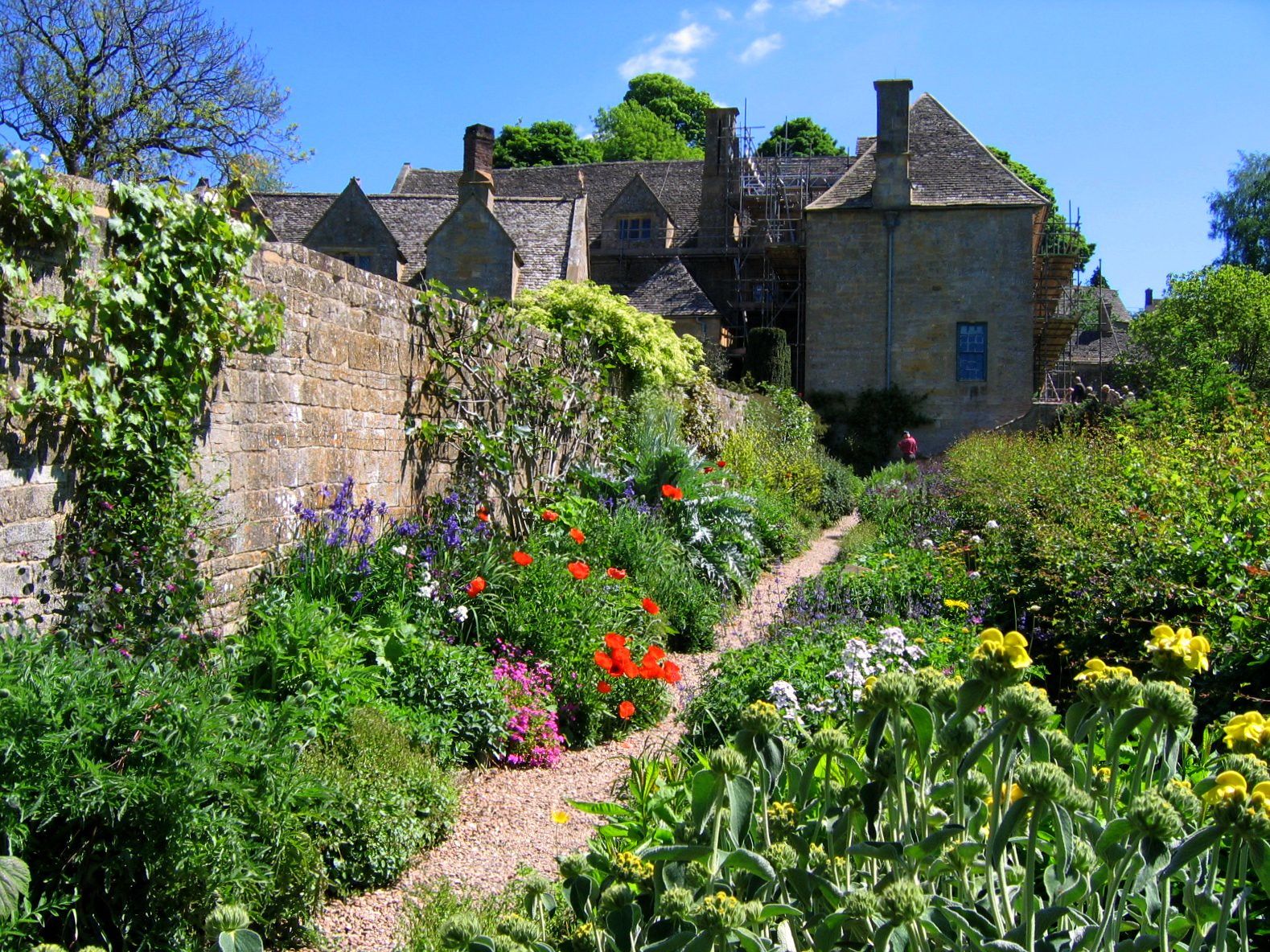
Snowshill Manor
A short drive away is Snowshill Manor, home of the eccentric collector, Charles Wade, who created a museum of fantastic memorabilia from around the world. Wade’s passion was for handmade crafts, at a time when mass manufacturing was becoming popular and everyone wanted mass-produced goods - not individually handcrafted items. His collection includes toys, suits of armour, furniture, and masks - it’s a real Aladdin’s cave of fascinating items.
My favourite piece is the armada chest dating back to the mid-1500s. Armada chests were originally used to store welfare payments for wounded sailors, during the Spanish Armada. They were later used as a safe for the rich to store their valuables. The snake-like locking mechanism on the inside lid is a fascinating piece of 16th-century engineering.
On the upper floor are traditional Japanese Samurai soldier uniforms. These scary-looking figures are sat around a glowing fire. It’s a dramatic scene. There’s also a room full of antique bicycles, one of musical instruments and one with a display of frightening masks that look like something from an African tribe. Nothing is labeled as Charles didn’t like labels. He felt they detracted from the beauty of the artefacts. Each room, however, has a knowledgeable guide, just itching to fill you in on the details of every weird and wonderful item.
Explore the villages
In the heart of the Cotswold countryside, the Slaughters are worth exploring. There’s a pretty river, craft shop, gift shop and pub. Upper Slaughter Manor is a magnificent Elizabethan house with a Jacobean porch and a medieval crypt. They serve drinks on the porch in the summertime. House tours are available and the gardens include a rose garden with a recreated 18th-century folly, riverside walk and a nature trail. It’s just beautiful.
Moreton-in-Marsh, is another picturesque Cotswold village, with quaint little shops, an interesting delicatessen, lots of antiques and a market. You’ll find Batsford Arboretum, and the Cotswold Falconry Centre in Moreton-in-Marsh too.
Nearby, the Rollright Stones is a Neolithic stone circle thought to date to around 2500BC. It was used for ceremonial purposes by Bronze Age pagans. The King Stone was thought to have been erected to mark a Bronze Age cemetery, dating to between 800 and 1500BC. It changed shape a lot over the years, mainly because 19th-century visitors chipped bits off, supposedly to keep the devil at bay. Partly for this reason, these stones were among the first to get legal protection from vandalism and become Scheduled Monuments. In the 1980s archaeologists found a burial chamber near the King Stone as well as evidence of cremations.
The Cotswolds are a great place to visit, packed with beautiful villages, charming landscapes, and diverse things to see and do. You don’t have to travel far between attractions, so it's easy to pack a lot into a single trip.
Find out more: www.cotswolds.com
* Originally published in the July / August 2020 issue of British Heritage Travel magazine.





Comments